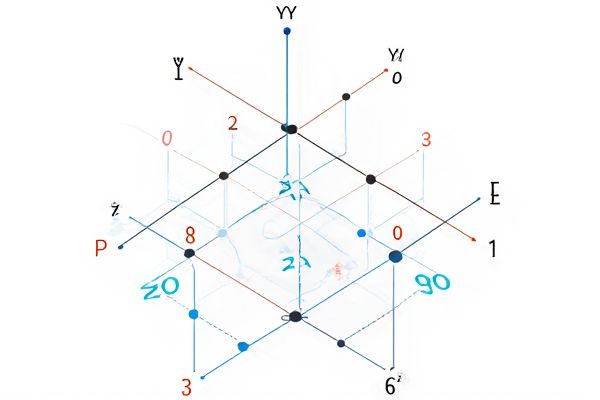
Explore endless possibilities by generating random XYZ coordinates with ease and precision. This online tool offers seamless customization to suit your specific needs, ensuring accurate spatial data every time. Experience a user-friendly interface designed for efficiency and instant results.
Online tool for random xyz coordinates generator
We have prepared several samples of a random XYZ coordinates generator for you to use and customize as needed. You can enter your own list or use the provided samples to generate randomized coordinates. With a single click, you will receive a randomized list and a single value ready for use.Data Source
Single Result
Multiple Results
Introduction to Random XYZ Coordinates Generation
Random XYZ coordinates generation involves producing sets of three-dimensional points with values typically constrained within defined spatial boundaries. This process is essential in fields like computer graphics, simulations, and spatial analysis where unpredictable or uniformly distributed positions are required. Algorithms for generating random XYZ coordinates often leverage uniform or Gaussian distributions to ensure mathematical randomness and relevance to application-specific contexts.
Applications of Random Coordinate Generators
Random XYZ coordinate generators are essential tools in computer graphics for procedural terrain generation, enabling the creation of complex, natural-looking landscapes. In scientific simulations, these generators facilitate stochastic modeling of particle distributions and molecular structures, enhancing the accuracy of experimental predictions. Robotics and autonomous systems rely on random coordinate generation to simulate sensor inputs and navigate dynamic environments effectively.
Key Algorithms for Generating XYZ Points
Key algorithms for generating random XYZ coordinates often utilize uniform distribution methods to ensure equal probability across the spatial range, enabling accurate simulations and modeling. Pseudorandom number generators (PRNGs) such as the Mersenne Twister are commonly implemented to produce reproducible and statistically robust XYZ point data. Optimization techniques like stratified sampling and rejection sampling enhance the precision and efficiency of spatial point distribution within defined 3D boundaries.
Defining Coordinate Range and Bounds
Defining coordinate range and bounds in a random XYZ coordinates generator ensures that generated points fall within specified spatial limits, optimizing accuracy for 3D modeling or simulations. Setting minimum and maximum values for X, Y, and Z axes restricts output to a defined volume, preventing out-of-range data errors. Precise boundary definitions enhance control over coordinate distribution, improving consistency in applications like graphics rendering and geographic data analysis.
Uniform vs Gaussian Distribution in XYZ Generation
Random XYZ coordinate generators often use either uniform or Gaussian distribution to model spatial data. Uniform distribution produces coordinates with equal probability across a defined range in all three axes, ideal for simulating evenly dispersed points. Gaussian distribution clusters coordinates around a mean value with a defined standard deviation, mimicking natural phenomena where values concentrate near the center and taper off at the edges.
Ensuring Reproducibility with Random Seeds
Random XYZ coordinates generators use random seeds to ensure reproducibility of spatial data, enabling consistent results across multiple runs. By initializing the generator with a specific seed value, the sequence of generated coordinates remains identical each time, facilitating debugging and verification in simulations. This deterministic approach is critical for scientific research and development where precise replication of experiments is required.
Optimizing Performance for Large Coordinate Sets
Efficient random XYZ coordinates generation for large datasets relies on vectorized operations using libraries like NumPy, significantly reducing computational overhead. Implementing spatial indexing structures such as KD-trees accelerates nearest neighbor searches within generated points, enhancing overall performance. Memory management strategies, including batch processing and data type optimization (e.g., using float32), ensure scalability and minimize latency in generating millions of coordinates.
Integrating Random Coordinates into 3D Visualizations
Integrating random XYZ coordinates into 3D visualizations enhances data representation by simulating spatial distributions or creating dynamic models. These coordinates, generated algorithmically, enable realistic rendering of scatter plots, particle systems, or terrain simulations in software like Unity or Blender. Optimizing the randomness parameters ensures diverse yet controlled spatial patterns essential for accurate visual analysis or immersive environments.
Common Pitfalls and Troubleshooting
Common pitfalls in using a random XYZ coordinates generator include generating biased or clustered points due to improper random number distributions and failing to validate coordinate ranges, which can lead to out-of-bounds values. Troubleshooting involves ensuring uniform random distribution algorithms are implemented, such as using well-tested pseudo-random number generators and applying range constraints to maintain coordinates within the desired spatial boundaries. Debugging tools can verify output accuracy by visualizing generated points and checking statistical properties to confirm even spatial coverage and detect anomalies.
Popular Tools and Libraries for XYZ Randomization
Popular tools and libraries for generating random XYZ coordinates include Python's NumPy library, which offers efficient random number generation for multidimensional arrays and is widely used in scientific computing. Other notable libraries like Three.js provide utilities for creating random 3D vectors, essential for web-based graphics and simulations. Additionally, software frameworks such as MATLAB and Unity come with built-in functions for XYZ randomization, supporting complex spatial modeling and game development.
 azrandom.com
azrandom.com